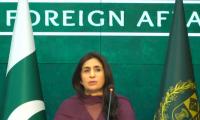LAHORE: A paradigm shift is needed in favour of renewable and locally produced fuels for electricity generation in a bid to fix Pakistan’s power woes, a prominent industrialist, Almas Hyder said the other day.
Talking to media persons at an Energy Security Group maiden meeting, Hyder was of the view that energy security assumes paramount importance in changing the geopolitical situation, as countries go to war to ensure energy security. “We must not forget that energy is the foundation of a good economy,” he observed.
The power generation mix for Pakistan is using indigenous resources like hydro, solar, wind, biogas, local coal, and nuclear. As far as transmission and distribution of electricity was concerned, the future was not about building large grids, but developing micro grids around small urban centres, he added.
Talking about the importance of renewables, Hyder said, renewables including solar and wind energy should be given utmost priority. “Today, the cheapest source of power generation available in Pakistan is solar power. In the US, solar PV plus storage are selling for 3.5 cents per kilowatt hour or kwh, which is around Rs4 in today’s conversion rate,” he observed.
Elsewhere, Electricite de France SA bid to supply power from a 300-megawatt photovoltaic plant for as little as 1.79 cents per kwh, the cheapest ever price on solar in the world. Earlier it was for a solar project in Abu Dhabi for 2.42 cents per kwh, he added.
In the last two years, US investment in solar power was 37 percent, wind 25 percent, hydro zero percent, and natural gas share in investment was 37 percent. In new investment, EU’s solar power share was 21 percent, wind 55 percent, hydro 4 percent and gas and coal 19 percent, etc. Similarly, China’s investment in new power generation capacity was mainly comprised by solar with 42 percent share, wind 12 percent, hydro 7 percent, while coal and nuclear share was 38 percent.
India’s investment in new power generation was also overwhelmed by solar with 38 percent share followed by wind with 31 percent share, hydro 13 percent, and 19 percent for others sources.
The trends of all leading economies of the world are clear – their current investments in hydropower are small to nil and shrinking where they still exist compared to solar and wind.
Talking about the energy scenario of Pakistan, Hyder said, Pakistan has been facing serious energy shortages, which have adversely impacted its economic growth.
The energy mix of Pakistan shifted from hydropower as a major source to a fossil fuel-led mix, over the last three decades. The key reason behind this shift remained the emergent reactions to emerging energy demand.
In the meantime, Pakistan’s dependence on imported energy resources accentuated, which led to limited availability at high economic cost.
With substantial increase in energy demand, Pakistan witnessed an unsparing energy crisis derailing its economic growth.
An official report recognises that during 2011-12 around 2 percent of gross domestic product (GDP) was lost due to the power sector outages. The distortions created by untargeted subsidies in both oil and gas sectors also played an adverse role in the economy, he viewed.
Pakistan has an installed electricity generation capacity of 28,704 megawatt as of May 20, 2018. The average demand is 25,389MW and the shortfall varies between 4,000 and 5,000MW.
Oil with about 17 percent share, hydro 26.08 percent, domestic gas 15.4 percent, imported RLNG 23.5 percent, coal 9.9 percent, wind and solar power 5.3 percent, and nuclear electricity with share of about 4.3 percent are the principal sources of power generation recorded in 2018, he said.
In the next about 10 years, Hyder said, “Peak electricity demand is expected to rise by four to five percent and we may need additional 20,000 to 25,000MW by the year 2030. This dismal forecast was due to a lopsided energy mix, diminishing indigenous fuel reserves, lingering circular debt and transmission hold-ups. Pakistan has almost exhausted its gas reserves.”
Moreover, hike in prices of imported oil affected the budgets. “Constant supply cannot be guaranteed amid the changing geopolitical canvas. So we are at a serious risk,” the industrialist said.
In the wake of the current circumstances, the reduction of import dependence should be the immediate priority; however, rational substitution was not possible overnight.
Pakistan has the potential to meet the energy challenges through many options, including through hydropower, but there were political and environmental issues in building dams.
“We can use indigenous alternate sources, which include wind, solar, biogas, agro-waste etc, but our decision makers are still not comfortable with them. LNG is difficult to import,” he added.
Energy remains probably the most important driver of the economy, and owing to this fact the world saw a boost in manufacturing, global trade, and trade of energy resources as well as associated technologies.
Dependence on fossil fuels had increased to nearly unsustainable levels and the need for more energy sources to support economic growth was felt more than ever before.
From the perspective of energy security, Hyder said, a suitable energy mix based on major share of indigenous resources was the need of the hour.
The significance of an integrated energy plan was undeniably a strategic need, which requires inputs from all the concerned stakeholders.
This was the right time for Pakistan to determine a dynamic energy mix that addresses the existing energy challenges as well as suffixes well with the economic and foreign policies in the broader national perspective, he concluded.
Sheikh argued that the government should have maintained stable petroleum prices
MARI has successfully drilled and tested the third appraisal well in the Ghazij formation in the Mari D&PL
Gold rates decreased by $17 to $2,395 per ounce in the international market
Company's revenue saw a 13.9% year-on-year increase, reaching Rs49.2 billion, up from Rs43.19 billion in the same...
A man counts US dollars in a money exchange shop in Dhaka. — AFP/FileLAHORE: The first thing that the government...
Power generation stood at 8,741 gigawatt-hours or 11,749 megawatts in March







